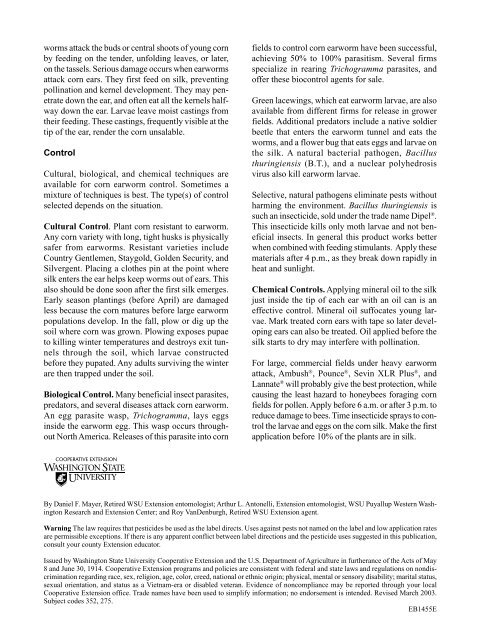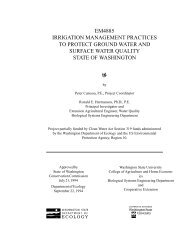CORN EARWORM - Washington State University
CORN EARWORM - Washington State University
CORN EARWORM - Washington State University
You also want an ePaper? Increase the reach of your titles
YUMPU automatically turns print PDFs into web optimized ePapers that Google loves.
worms attack the buds or central shoots of young corn<br />
by feeding on the tender, unfolding leaves, or later,<br />
on the tassels. Serious damage occurs when earworms<br />
attack corn ears. They first feed on silk, preventing<br />
pollination and kernel development. They may penetrate<br />
down the ear, and often eat all the kernels halfway<br />
down the ear. Larvae leave moist castings from<br />
their feeding. These castings, frequently visible at the<br />
tip of the ear, render the corn unsalable.<br />
Control<br />
Cultural, biological, and chemical techniques are<br />
available for corn earworm control. Sometimes a<br />
mixture of techniques is best. The type(s) of control<br />
selected depends on the situation.<br />
Cultural Control. Plant corn resistant to earworm.<br />
Any corn variety with long, tight husks is physically<br />
safer from earworms. Resistant varieties include<br />
Country Gentlemen, Staygold, Golden Security, and<br />
Silvergent. Placing a clothes pin at the point where<br />
silk enters the ear helps keep worms out of ears. This<br />
also should be done soon after the first silk emerges.<br />
Early season plantings (before April) are damaged<br />
less because the corn matures before large earworm<br />
populations develop. In the fall, plow or dig up the<br />
soil where corn was grown. Plowing exposes pupae<br />
to killing winter temperatures and destroys exit tunnels<br />
through the soil, which larvae constructed<br />
before they pupated. Any adults surviving the winter<br />
are then trapped under the soil.<br />
Biological Control. Many beneficial insect parasites,<br />
predators, and several diseases attack corn earworm.<br />
An egg parasite wasp, Trichogramma, lays eggs<br />
inside the earworm egg. This wasp occurs throughout<br />
North America. Releases of this parasite into corn<br />
fields to control corn earworm have been successful,<br />
achieving 50% to 100% parasitism. Several firms<br />
specialize in rearing Trichogramma parasites, and<br />
offer these biocontrol agents for sale.<br />
Green lacewings, which eat earworm larvae, are also<br />
available from different firms for release in grower<br />
fields. Additional predators include a native soldier<br />
beetle that enters the earworm tunnel and eats the<br />
worms, and a flower bug that eats eggs and larvae on<br />
the silk. A natural bacterial pathogen, Bacillus<br />
thuringiensis (B.T.), and a nuclear polyhedrosis<br />
virus also kill earworm larvae.<br />
Selective, natural pathogens eliminate pests without<br />
harming the environment. Bacillus thuringiensis is<br />
such an insecticide, sold under the trade name Dipel ® .<br />
This insecticide kills only moth larvae and not beneficial<br />
insects. In general this product works better<br />
when combined with feeding stimulants. Apply these<br />
materials after 4 p.m., as they break down rapidly in<br />
heat and sunlight.<br />
Chemical Controls. Applying mineral oil to the silk<br />
just inside the tip of each ear with an oil can is an<br />
effective control. Mineral oil suffocates young larvae.<br />
Mark treated corn ears with tape so later developing<br />
ears can also be treated. Oil applied before the<br />
silk starts to dry may interfere with pollination.<br />
For large, commercial fields under heavy earworm<br />
attack, Ambush ® , Pounce ® , Sevin XLR Plus ® , and<br />
Lannate ® will probably give the best protection, while<br />
causing the least hazard to honeybees foraging corn<br />
fields for pollen. Apply before 6 a.m. or after 3 p.m. to<br />
reduce damage to bees. Time insecticide sprays to control<br />
the larvae and eggs on the corn silk. Make the first<br />
application before 10% of the plants are in silk.<br />
By Daniel F. Mayer, Retired WSU Extension entomologist; Arthur L. Antonelli, Extension entomologist, WSU Puyallup Western <strong>Washington</strong><br />
Research and Extension Center; and Roy VanDenburgh, Retired WSU Extension agent.<br />
Warning The law requires that pesticides be used as the label directs. Uses against pests not named on the label and low application rates<br />
are permissible exceptions. If there is any apparent conflict between label directions and the pesticide uses suggested in this publication,<br />
consult your county Extension educator.<br />
Issued by <strong>Washington</strong> <strong>State</strong> <strong>University</strong> Cooperative Extension and the U.S. Department of Agriculture in furtherance of the Acts of May<br />
8 and June 30, 1914. Cooperative Extension programs and policies are consistent with federal and state laws and regulations on nondiscrimination<br />
regarding race, sex, religion, age, color, creed, national or ethnic origin; physical, mental or sensory disability; marital status,<br />
sexual orientation, and status as a Vietnam-era or disabled veteran. Evidence of noncompliance may be reported through your local<br />
Cooperative Extension office. Trade names have been used to simplify information; no endorsement is intended. Revised March 2003.<br />
Subject codes 352, 275.<br />
EB1455E
















